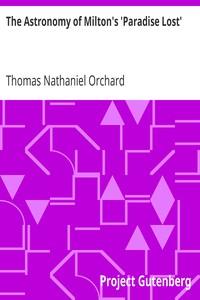Read this ebook for free! No credit card needed, absolutely nothing to pay.
Words: 31498 in 7 pages
This is an ebook sharing website. You can read the uploaded ebooks for free here. No credit cards needed, nothing to pay. If you want to own a digital copy of the ebook, or want to read offline with your favorite ebook-reader, then you can choose to buy and download the ebook.


: The Astronomy of Milton's 'Paradise Lost' by Orchard Thomas Nathaniel - Milton John 1608-1674. Paradise lost; Milton John 1608-1674 Knowledge Astronomy; Epic poetry English History and criticism; Astronomy in literature Astronomy
stic points in favour of this theory:--
Between the orbits of Mars and Jupiter there revolves a remarkable group of small planets or planetoids. On account of the absence of a planet in this region, where, according to the laws of planetary distances, one ought to be found, the existence of those small bodies was suspected for some years prior to their discovery. The first was detected by Piazzi at Palermo in 1801; two others were discovered by Olbers in 1802 and 1807, and one by Harding in 1804. For some time it was believed that no more planetoids existed, but in 1845 a fifth was detected by Hencke, and from that year until now upwards of 300 of those small bodies have been discovered. Their magnitudes are of varied extent; the diameter of the largest is believed not to exceed 450 miles, and that of the smaller ones from twenty to thirty miles. It was surmised at one time, when only a few of those bodies were known, that they were the fragments of a planet which met with some terrible catastrophe; but since the discovery of so many other planetoids this theory cannot be maintained. According to the nebular hypothesis, these bodies are the consolidated portions of a nebulous ring which remained separate instead of having coalesced into one mass so as to form a planet. The uniform condensation of the ring would result in the formation of a multitude of small planets similar to what are found between the orbits of Mars and Jupiter. In Saturn's ring we have a remarkable instance of annular consolidation in which the form of the ring has been preserved. The ring is believed to consist of myriads of minute bodies, each of which travels in an orbit of its own as it pursues its path round the planet; the close approximation and exceeding minuteness of those moving objects create the appearance of a solid continuous ring.
No attempt has been made to supplant the nebular hypothesis by any other theory of cosmical evolution. Modern investigations and discoveries have strengthened its position, and at present it is the only means by which we can account for the existence of the visible material universe by which we are surrounded.
In the days when Milton lived--three hundred years ago--the nocturnal heavens presented the same appearance to an observer as they do at the present time. The stars pursued their identical paths, and looked down upon the Earth with the same aspect of serene tranquillity, regardless of the vicissitudes which affect the inhabitants of this terrestrial sphere. The constellations that adorn the celestial vault duly appeared in their seasons,
and in the ascending scale Of Heaven the stars that usher evening rose.--iv. 354-55.
The winter glories of Orion, the scintillating brilliancy of Sirius, and the spangled firmament, bearing no impress of change or variation which would lead one to conclude that the heavens were other than eternal, attracted then, as now, the admiration of beholders.
Though Milton makes frequent allusion to the magnificence of the starry heavens, we have no evidence that he regarded the stars as suns, nor does he refer to them as such in any part of his poem. What impressed him most was their number and brilliancy, to which reference is made in the following passages:
About him all the Sanctities of Heaven Stood thick as stars.--iii. 60-61.
And sowed with stars the Heavens thick as a field.--vii. 358.
Amongst innumerable stars, that shone Stars distant, but nigh hand seemed other worlds.--iii. 564-65.
her reign With thousand lesser lights dividual holds, With thousand thousand stars, that then appeared Spangling the hemisphere.--vii. 381-84.
Milton describes the number of the fallen angels as
Free books android app tbrJar TBR JAR Read Free books online gutenberg
More posts by @FreeBooks

: The Black Buccaneer by Meader Stephen W Stephen Warren - Adventure stories; Pirates Juvenile fiction; Bonnet Stede -1718 Juvenile fiction; Buccaneers Juvenile fiction


: Harper's Young People March 23 1880 An Illustrated Weekly by Various - Children's periodicals American Harper's Young People






